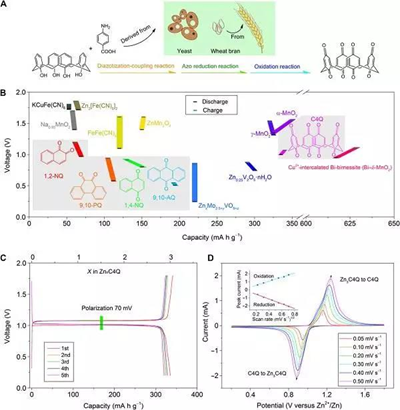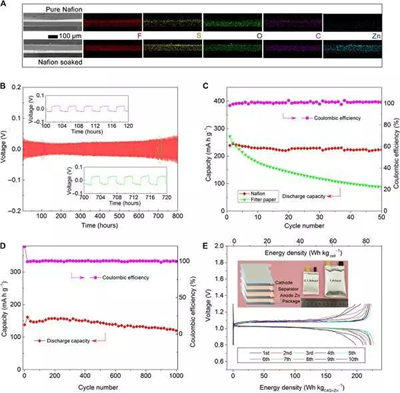Academician Jun Chen’s group reported aqueous zinc-quinone batteries in Sci. Adv.
Developing high-performance rechargeable batteries is vital for regulating the energy output of intermittent solar and wind energy, which have been expected to occupy increasing proportions in energy distribution in light of the environmental issues caused by fossil energy. Batteries using organic electrodes are attractive electrochemical energy storage devices because organic compounds can be lightweight, environmentally friendly, and sustainable. Rechargeable zinc batteries (ZBs) are one of the most promising candidates because zinc anodes are affordable and exhibit high capacity, large production, and good compatibility with water.
Professor Jun Chen’s group studied a series of different quinone compounds as high-performance cathodes in aqueous ZBs. The calix[4]quinone (C4Q) with open bowl structures and eight carbonyls exhibits a high capacity, a flat and safe operation voltage, and a low polarization with high energy efficiency of 93% at low current density.

To further confirm the active center of C4Q, an ATR-FTIR battery was designed to investigate the variation of quinone with Zn ion uptake/removal. The stretching vibration of carbonyl is at about 1650 cm−1. With the in-depth process of discharging, the intensity of the carbonyl vibration peak declines, indicating the reaction between Zn ions and carbonyl. The intensity rises again to a high level after the charging process, indicating the removal of the Zn ion from C4Q.

This battery system demonstrates good performance. The capacity retention is 93% after 100 cycles. Furthermore, the morphology evolution shows the protection of the Zn anode without the generation of the by-product. Moreover, after 1000 cycles at 500 mA g−1, the capacity retention is still 87%, which only declines at 0.015% per cycle. The ZnC4Q batteries with the Nafion separator also display decent rate performance.

Through using multicarbonyl quinone compounds composed of naturally abundant elements (C, H, and O), the family of electrode materials for aqueous ZBs was enriched. These organic material–based aqueous metal (Zn and Mg) batteries have produced interesting topics. Through elaborately designing the molecular structure, more organic materials with higher capacity and voltage will be available in further studies.
This work was supported by the National Programs for Nano-Key Project, the National Natural Science Foundation of China, and the 111 Project of Ministry of Education. This research was published in the international multidisciplinary scientific journal-Science Advances. The first author is PhD. Qing Zhao and the joint first author is PhD. Weiwei Huang.
More detailed information on this work, please click here:
http://advances.sciencemag.org/content/4/3/eaao1761

